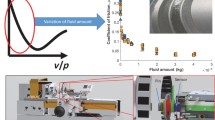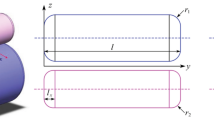Abstract
The lubricant significantly influences the performance of rolling-sliding contacts. On the one hand, the normal force is transmitted by the lubricant in consequence of hydrodynamic effects and on the other hand, the solid friction between the contacting asperities can be reduced. In this report, a novel calculation approach for mixed lubrication conditions is presented. Besides the consideration of measured surface structures, the calculation approach can be applied to application-oriented rolling-sliding contacts with large contact areas. Based on the elastic half-space theory according to boussinesq/love/hartnett, an adapted solving algorithm for the micro contact calculation is presented. Instead of the established adhesion boundary condition, which leads to a pressure of zero in the area of the roughness valleys, a lubricant boundary condition is introduced. Based on this lubricant boundary condition, the influence of the fluid pressure on the elastic deformation of the rough surface can be directly regarded. The resulting cross influences of deformation affect the solid contact pressure as well as the size of the lubrication pockets. The proposed solving algorithm is extended to a method for calculating the pressure distribution under mixed lubrication. The calculation method is validated by friction force measurements on a disc-on-disc test rig, whereby the normal force as well as different surface structures are specifically varied. The method confirms the changes of the friction coefficient for different normal forces as well as for different surface structures. Furthermore, the chart of solid-contact-load-ratio can be derived, which is mostly a missing link in tribological calculation models for different surface topographies.
Zusammenfassung
In vielen Anwendungen werden hochbelastete Wälzkontakte im Mischreibungsgebiet betrieben, weil die Hydrodynamik des Schmierspalts nicht zu einer vollständigen Oberflächentrennung ausreicht. Die wesentlichen Einflussgrößen auf die Leistungsfähigkeit eines Tribosystems im Mischreibungsgebiet sind auf der mikroskopischen Ebene verankert, wie bspw. die Oberflächenrauheit. Bei bestehenden Berechnungsansätzen werden auf Mikroebene Hilfsmodelle aufgebaut, die durch Kennfelder mit dem Hauptmodell auf Makroebene verknüpft werden. Durch die Kennfeldbildung wird die Berechenbarkeit praxisnaher Wälzkontakte ermöglicht, jedoch ein Informationsverlust der Ausgabegrößen auf Mikroebene in Kauf genommen. In diesem Bericht wird eine neuartige Methode zur Berechnung von Mischreibungszuständen vorgestellt. Auf Basis der „Methode kombinierter Lösungen“ wird das Hauptmodell auf Mikroebene verankert und durch Kennfelder mit den Erkenntnissen makroskopischer Berechnungsmodelle verknüpft. Dazu wird die Mikrokontaktberechnung im elastischen Halbraum um ein Schmierstoffmodell erweitert, bei dem die Verformungskreuzeinflüsse des Schmierstoffdrucks in den Rauheitstälern bei der Lösung des linearen Gleichungssystem integriert werden. Zur Bewertung unterschiedlicher Mischreibungszustände wird die Gleichgewichtsbedingung eingeführt, dass das hydrodynamisch geförderte Schmierstoffvolumen die Rauheitstäler der elastisch verformten Kontaktgeometrie füllen muss. Auf diese Weise können alle Zustände im Mischreibungsgebiet auf Mikroebene berechnet werden. Zur Validierung der Berechnungsmethode werden Stribeck-Kurven bei konstanter Gleitgeschwindigkeit auf einem Zwei-Scheiben-Reibkrafttribometer durchgeführt. Neben unterschiedlichen Oberflächenrauheiten und –strukturen wird die Lastabhängigkeit der Stribeck-Kurve bei gleicher Oberflächentopographie untersucht. Der Vergleich zwischen Experiment und Berechnung zeigt insbesondere für unterschiedliche Normalkräfte eine gute Übereinstimmung, weil sowohl die Start- und Endpunkte des Mischreibungsgebiets für alle drei Lastniveaus als auch der Schnittpunkt der Stribeck-Kurven quantitativ getroffen werden. Beim Vergleich einer geschliffenen mit einer hartgedrehten Oberflächenstruktur wird der unterschiedliche Gradient der Stribeck-Kurve aus dem Experiment von der Kontaktberechnung bestätigt, sodass ebenfalls unterschiedliche Oberflächenstrukturen hinsichtlich des tribologischen Einsatzverhaltens bewertet werden können.















Similar content being viewed by others
Abbreviations
- 1:
-
Index of test shaft, –
- 2:
-
Index of counter shaft, –
- A :
-
Contact area for evaluation, mm2
- A solid :
-
Area of solid contact, mm2
- A total :
-
Total contact area, mm2
- b :
-
Contact width, mm
- Bx, by :
-
Element size, mm
- C j→k :
-
Influence number, –
- D a :
-
Outer diameter, mm
- f :
-
Fluid pressure factor, –
- F N :
-
Normal force, N
- F N,solid :
-
Normal force transferred at the solid contact points, N
- F N,total :
-
Total normal force, N
- F R :
-
Friction force, N
- g :
-
Gap distance between the plane and the deformed geometry, mm
- h :
-
Initial separation in the unloaded state, mm
- H mean :
-
Average lubrication pocket height, mm
- i :
-
Index of element, –
- j :
-
Index of loaded element, –
- k :
-
Index of deformed element, –
- M :
-
Total number of elements, –
- n :
-
Turning speed, 1/min
- p :
-
Normal pressure distribution, N/mm2
- P max :
-
Normal pressure distribution, N/mm2
- P fluid :
-
Fluid pressure, MPa
- P lim :
-
Limit pressure for ideal plastic material modell, MPa
- P solid :
-
Mean solid contact pressure, MPa
- R :
-
Radius of discs, mm
- Ra, Rz, R q :
-
Roughness parameter, µm
- u :
-
Complete elastic deformation, mm
- u 0 :
-
Initial approach of one body to the other, mm
- U micro :
-
Approach of one body to the other for micro contact calculation, mm
- U smooth :
-
Approach of one body to the other for smooth contact calculation, mm
- X OS :
-
Surface structure factor according to Doleschel, –
- λ rel :
-
Film thickness ratio, –
- ψ area :
-
Solid contact area ratio, –
- ψ load :
-
Solid contact load ratio, –
- μ fluid :
-
Friction coefficient of the fluid, –
- μ mean :
-
Mean friction coefficient, –
- μ solid :
-
Solid friction coefficient, –
References
Oster P (1982) Beanspruchung der Zahnfanken unter Bedingungen der Elastohydrodynamik. Diss. TU München
Schlecht B (2010) Maschinenelemente: Getriebe, Verzahnungen und Lagerungen, 1st edn. vol 2. Pearson, London
Hamrock BJ, Schmid SR, Jacobson BO (2004) Mechanical engineering, 2nd edn. Fundamentals of fluid film lubrication, vol 169. Dekker, New York
Yang C, Tartaglino U, Persson BNJ (2006) A multiscale molecular dynamics approach to contact mechanics. Eur Phys J E Soft Matter 19(1):47–58. https://doi.org/10.1140/epje/e2006-00004-9
Campañá C, Müser MH (2006) Practical Green’s function approach to the simulation of elastic semi-infinite solids. Phys Rev B 74(7):R7. https://doi.org/10.1103/PhysRevB.74.075420
Putignano C, Afferrante L, Carbone G et al (2012) A new efficient numerical method for contact mechanics of rough surfaces. Int J Solids Struct 49(2):338–343. https://doi.org/10.1016/j.ijsolstr.2011.10.009
Campañá C, Müser MH, Robbins MO (2008) Elastic contact between self-affine surfaces: Comparison of numerical stress and contact correlation functions with analytic predictions. J. Phys.: Condens. Matter 20(35): 354013. https://doi.org/10.1088/0953-8984/20/35/354013
Campañá C, Persson BNJ, Müser MH (2011) Transverse and normal interfacial stiffness of solids with randomly rough surfaces. J Phys Condens Matter 23(8):85001. https://doi.org/10.1088/0953-8984/23/8/085001
Putignano C, Afferrante L, Carbone G et al (2012) The influence of the statistical properties of self-affine surfaces in elastic contacts: A numerical investigation. J Mech Phys Solids 60(5):973–982. https://doi.org/10.1016/j.jmps.2012.01.006
Putignano C, Afferrante L, Carbone G et al (2013) A multiscale analysis of elastic contacts and percolation threshold for numerically generated and real rough surfaces. Tribol Int 64:148–154. https://doi.org/10.1016/j.triboint.2013.03.010
Yang C, Persson BNJ (2008) Molecular dynamics study of contact mechanics: Contact area and interfacial separation from small to full contact. Phys Rev Lett 100(2):24303. https://doi.org/10.1103/PhysRevLett.100.024303
Yang C, Persson BNJ (2008) Contact mechanics: Contact area and interfacial separation from small contact to full contact. J. Phys.: Condens. Matter 20(21): 215214. https://doi.org/10.1088/0953-8984/20/21/215214
Paggi M, He Q‑C (2015) Evolution of the free volume between rough surfaces in contact. Wear 336–337:86–95. https://doi.org/10.1016/j.wear.2015.04.021
Bartel D (2010) Simulation von Tribosystemen: Grundlagen und Anwendungen. Vieweg+Teubner, Wiesbaden
Solovyev S (2007) Reibungs- und Temperaturberechnung an Festkörper- und Mischreibungskontakten. Diss, Otto-von-Guericke-Universität Magdeburg
Scholz U (2008) Instationäre Berechnung geschmierter Wälzkontakte. Diss, Otto-von-Guericke-Universität Magdeburg
Albers A, Savio D, Lorentz B (2010) Numerical investigations of mixed lubricated systems taking into account surface roughness. In: Gesellschaft für Tribologie e. V. (ed) 51. Tribologie-Fachtagung: Reibung, Schmierung und Verschleiß. Eigendruck der Gesellschaft für Tribologie e. V., Aachen
Kweh CC, Patching MJ, Evans HP et al (1992) Simulation of Elastohydrodynamic Contacts Between Rough Surfaces. J Tribol 114(3):412. https://doi.org/10.1115/1.2920900
Chang L, Webster MN (1991) A Study of Elastohydrodynamic Lubrication of Rough Surfaces. J Tribol 113(1):110. https://doi.org/10.1115/1.2920574
Wang QJ, Zhu D, Cheng HS et al (2004) Mixed Lubrication Analyses by a Macro-Micro Approach and a Full-Scale Mixed EHL Model. J Tribol 126(1):81. https://doi.org/10.1115/1.1631017
Venner CH, Lubrecht AA (1996) Numerical Analysis of the Influence of Waviness on the Film Thickness of a Circular EHL Contact. J Tribol 118(1):153. https://doi.org/10.1115/1.2837071
Redlich A (2002) Simulation von Punktkontakten unter Mischreibungsbedingungen. Diss, Otto-von-Guericke-Universität Magdeburg
Schönecker C (2013) Flow Phenomena at Microstructured Surfaces. Diss, TU Darmstadt
Hu Y‑z, Wang H, Wang W‑z et al. (2001) A computer model of mixed lubrication in point contacts. Tribol. International 34(1): 65–73. https://doi.org/10.1016/S0301-679X(00)00139-0
Zhu D, Wang QJ (2012) On the ratio range of mixed lubrication. J Eng Tribol 226(12):1010–1022. https://doi.org/10.1177/1350650112461867
Lubrecht AA, ten Napel WE, Bosma R (1988) The Influence of Longitudinal and Transverse Roughness on the Elastohydrodynamic Lubrication of Circular Contacts. J Tribol 110(3):421. https://doi.org/10.1115/1.3261645
Yastrebov VA, Anciaux G, Molinari J‑F (2015) From infinitesimal to full contact between rough surfaces: Evolution of the contact area. Int J Solids Struct 52:83–102. https://doi.org/10.1016/j.ijsolstr.2014.09.019
Patir N, Cheng HS (1978) An Average Flow Model for Determining Effects of Three-Dimensional Roughness on Partial Hydrodynamic. Lubr J Lub Tech 100(1):12–17. https://doi.org/10.1115/1.3453103
Nyemeck AP, Brunetière N, Tournerie B (2012) A Multiscale Approach to the Mixed Lubrication Regime: Application to Mechanical Seals. Tribol Lett 47(3):417–429. https://doi.org/10.1007/s11249-012-9997-5
Bartel D (2001) Berechnung von Festkörper- und Mischreibung bei Metallpaarungen. Diss, Otto-von-Guericke-Universität Magdeburg
Neubert S, Porat A, Hentschke C et al (2013) Mixed friction model for rough contacts at high pressure. J Eng Tribol 227(5):496–509. https://doi.org/10.1177/1350650113479512
Brunetiere N, Wang QJ (2014) Large-Scale Simulation of Fluid Flows for Lubrication of Rough Surfaces. J. Tribol. 136(1): 011701-1–011701-14
Love AEH (1929) The Stress Produced in a Semi-Infinite Solid by Pressure on Part of the. Boundary J Math Phys Eng Sci 228:377–420. https://doi.org/10.1098/rsta.1929.0009
Boussinesq J (1885) Application des potentiels à l’étude de l’équilibre et du mouvement des solides élastiques. Gauthier-Villars, Paris
Hartnett MJ (1979) The Analysis of Contact Stresses in Rolling Element. Bear J Lub Tech 101(1):105–109. https://doi.org/10.1115/1.3453270
Nadermann D, Elter A, Schwarze H (2017) Contact simulation of real worn surfaces with polymeric composites on the microscale. In: Gesellschaft für Tribologie e. V. (ed) 58. Tribologie-Fachtagung: Reibung, Schmierung und Verschleiß. Eigendruck der Gesellschaft für Tribologie e. V., Aachen
Brecher C, Renkens D, Löpenhaus C (2016) Method for Calculating Normal Pressure Distribution of High Resolution and Large Contact Area. J. Tribol. 138(1): 011402-1–011402-9
Brecher C, Löpenhaus C, Mevissen D (2016) Methode zur Pressungsberechnung mit gemessenen Oberflächenstrukturen. In: Gesellschaft für Tribologie e. V. (ed) 57. Tribologie-Fachtagung: Reibung, Schmierung und Verschleiß. Eigendruck der Gesellschaft für Tribologie e. V., Aachen
Allwood J (2005) Survey and. Tribol, vol 127. Performance, Assessment of Solution Methods for Elastic Rough Contact Problems. J, pp 10–23
Dowson D, Higginson GR (1977) Elasto-hydrodynamic lubrication, 2nd edn. International series on materials science and technology, vol 23. Pergamon Press, Oxford
Löpenhaus C (2015) Untersuchung und Berechnung der Wälzfestigkeit im Scheiben- und Zahnflankenkontakt. Diss, RWTH Aachen University
Doleschel A (2003) Wirkungsgradberechnung von Zahnradgetrieben in Abhängigkeit vom Schmierstoff. Diss, TU München
Masjedi M, Khonsari MM (2012) Film Thickness and Asperity Load Formulas for Line-Contact Elastohydrodynamic Lubrication With Provision for Surface Roughness. J. Tribol. 134(1): 011503-1–011503-10. https://doi.org/10.1115/1.4005514
Stribeck R (1903) Die wesentlichen Eigenschaften der Gleit- und Rollenlager. Mitteilungen über Forschungsarbeiten auf dem Gebiete des Ingenieurwesens, insbesondere aus den Laboratorien der technischen Hochschulen. Springer, Berlin
Michaelis K (1987) Die Integraltemperatur zur Beurteilung der Fresstragfähigkeit von Stirnradgetrieben. Diss, TU München
Popov V (2010) Kontaktmechanik und Reibung: Von der Nanotribologie bis zur Erdbebendynamik. Springer, Springer, Berlin
Murch LE, Wilson WRD (1975) A Thermal Elastohydrodynamic Inlet Zone. Analysis J Lub Tech 97(2):212. https://doi.org/10.1115/1.3452559
Funding
The authors gratefully acknowledge financial support by the German Research Foundation (DFG) [KL500/188-1] for the achievement of the project results.
Author information
Authors and Affiliations
Corresponding author
Rights and permissions
About this article
Cite this article
Mevissen, D., Löpenhaus, C. & Bergs, T. Calculation of mixed friction conditions in large-Scale rolling-Sliding contacts for different surface structures. Forsch Ingenieurwes 83, 351–366 (2019). https://doi.org/10.1007/s10010-019-00377-y
Received:
Accepted:
Published:
Issue Date:
DOI: https://doi.org/10.1007/s10010-019-00377-y




